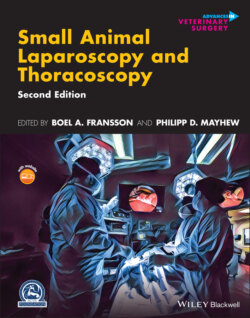Читать книгу Small Animal Laparoscopy and Thoracoscopy - Группа авторов - Страница 119
Specimen Retrieval Bags
ОглавлениеPrior to the development of specimen retrieval bags, minimally invasive surgeons removed intracorporeally resected tissue through unprotected port sites and small incisions. Manipulating infectious or neoplastic specimens through port incisions can lead to the uncommon but serious complication of port‐site metastasis or infection [1, 2]. The use of a retrieval bag allows for a contained extraction of potentially harmful tissue within an impermeable pouch and has been documented to reduce port or incision site contamination [3–6]. In veterinary medicine, specimen retrieval bags have been most often reported for use in minimally invasive cholecystectomy and tumor resections in the thorax and abdomen [7–9].
There are several commercially available specimen retrieval devices available as well as more economical options. Most commercial specimen retrieval bags are pouchlike and preloaded within a delivery system (Figure 4.25). They are typically made from durable synthetic materials that can withstand aggressive handling and have a low incidence of tearing and subsequent content spillage. The majority of commercially available specimen retrieval bags are introduced into the body via a 10‐ to 12‐mm cannula; however, smaller retrieval bags are also available for use with 5‐mm cannulas. Commercially available retrieval bags typically have a rigid expandable rim (Figure 4.25c), designed to maintain the bag in an open position to facilitate tissue manipulation into the bag. The expandable ring expands as the bag is deployed from its hollow instrument shaft and collapses again upon withdrawal [3, 4, 6]. (Video 4.1). Examples of homemade cost‐effective specimen retrieval bags include sterilized latex glove fingers (powderless), zipper storage bags, and condoms [3, 4, 6] (Figure 4.26a and b).
Prior to physical removal of the tissue‐occupied retrieval bag from a body cavity, the tissue to be extracted should be adjusted to the bottom of the bag. This can often be achieved by simply elevating the bag and allowing the weight of the tissue to shift its position deeper inside of the bag. In scenarios with less working space, an instrument is used to push the tissue to the bottom of the bag.
Some commercially available products allow for intracorporeal bag closure using an embedded purse string around the opening (see Figure 4.25b). The long tethers of the purse string are withdrawn out of body cavity through the desired exit site (typically a cannula), pulling the closed specimen bag along with them. Once the opening of the bag is within the cannula, the bag and cannula can be pulled from the site as a single unit. Bags with small tissue volumes can often be successfully removed through a larger cannula (12 mm). Bags with large tissue volumes can often be slowly pulled through the incision after the cannula is removed without the need to extend the size of the incision. If the specimen is too large for the cannula incision, manual or power tissue morcellation of the tissue within the bag, or enlargement of the port incision, may be performed to facilitate removal. Manual morcellation is performed by bringing the bag opening to the enlarged cannula incision and using a blunt‐tipped standard surgical forceps (eg. carmalt, ring) to disrupt the contained tissues into smaller, more pliable tissue. Firmer tissue can be clamped, partially exteriorized, and surgically debulked without disruption of the specimen bag. Fluid‐filled structures, such as an excised gallbladder, can have their contents removed or aspirated while inside a bag to facilitate extraction. Surgeons should avoid overzealously pulling or forcing a retrieval bag through an insufficient incision. When in doubt, the incision should be extended to enable safe removal of the occupied bag without undue risk of disruption and subsequent contamination. In particular, homemade retrieval bags are often more fragile and care is required to avoid tears during extraction from the abdomen [3, 4, 6].
Figure 4.25 (A). Homemade retrieval bags are cost effective. (B). Commercially available retrieval bags have a purse string that closes the bag before exteriorizing it through a port site. (C). Commercially available retrieval bags have a rigid rim that maintains a large opening of the bag, greatly facilitating insertion of tissue.
Figure 4.26 (A). A homemade retrieval bag for small lesions can be made out of a surgical glove. (B). Whereas a homemade retrieval bag requires a grasper to hold on to the bag, commercial bags often include a delivery system.
